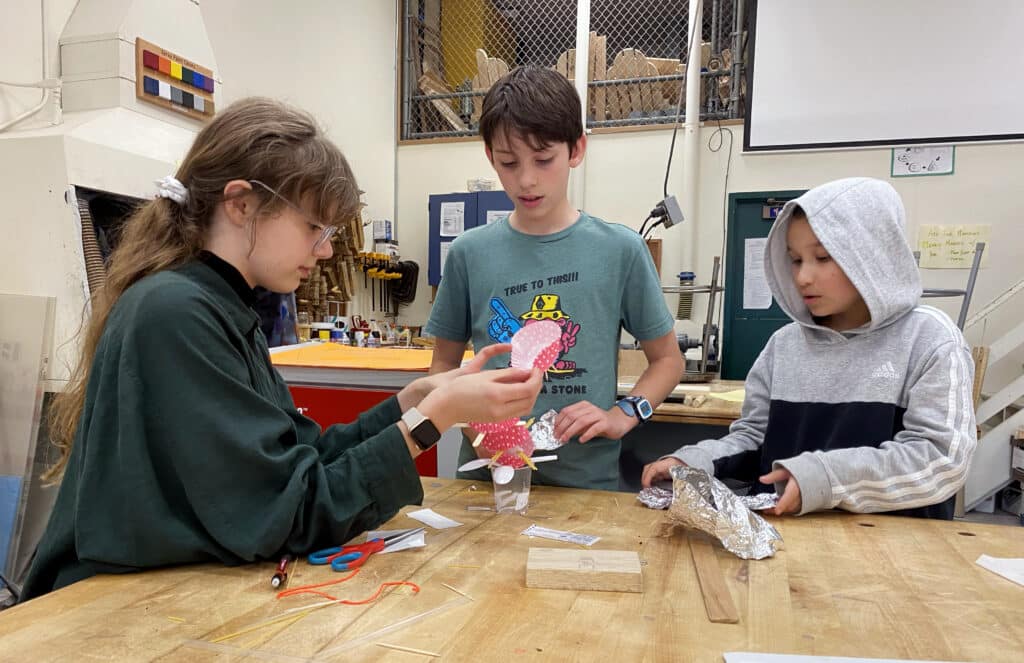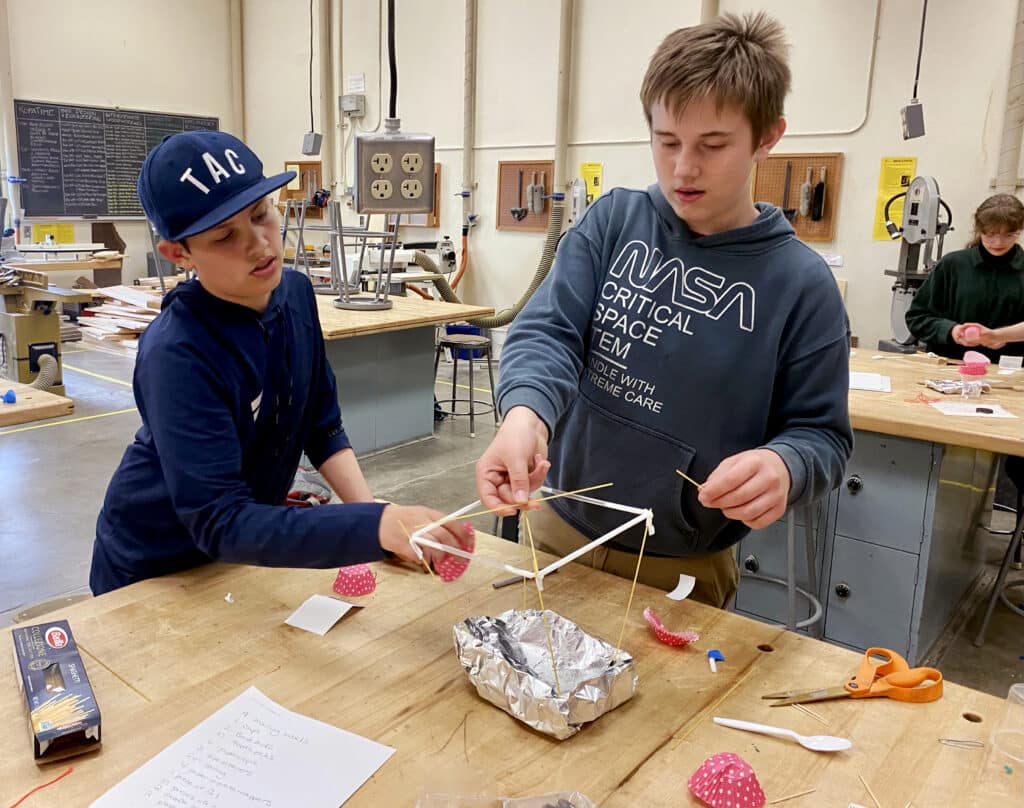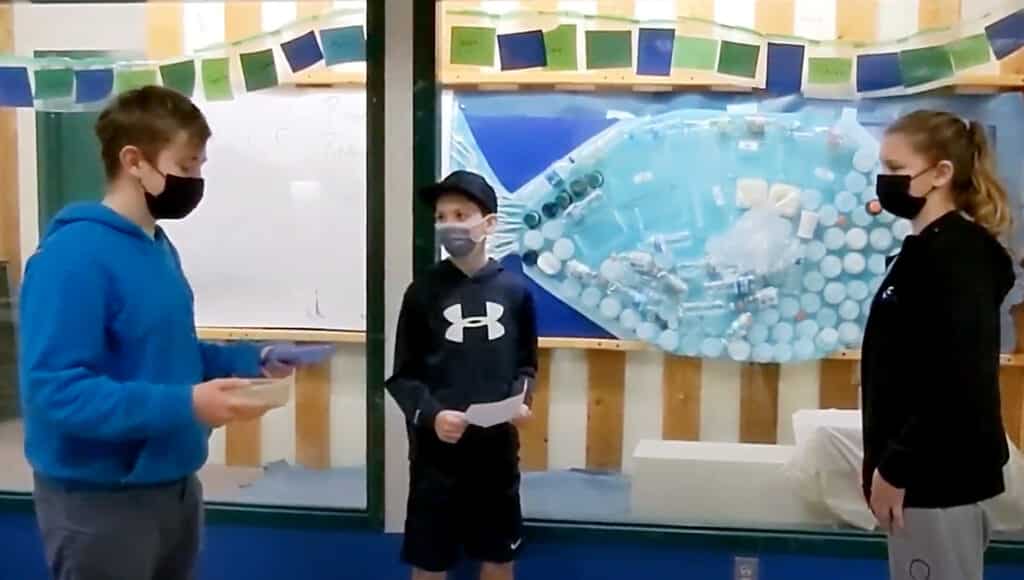Community Education
Students measure plastic waste at Kopachuck Middle School
Students in the STEAM Club at Kopachuck Middle School wanted to find out how much plastic waste was generated on their campus.
Education Sponsor
Education stories are made possible in part by Tacoma Community College, a proud sponsor of Gig Harbor Now.
They recently spent a couple weeks collecting empty drink bottles, sandwich bags, food packaging, plastic utensils and other plastic waste during lunchtime.
The project was inspired by National Geographic’s Planet or Plastic?, a multi-year effort to “raise awareness about the global plastic trash crisis.”

Some of the waste Kopachuck students intercepted would have gone into recycling containers. But before the project started, they made the rounds asking their peers to pitch in to their collection bins instead so they could quantify the waste.
STEAM fosters innovation
“We’re trying to introduce middle schoolers to STEAM: science, technology, engineering, math and art,” said STEAM Club advisor Eileen Schurer, who led the plastics project. “We want a fun club where kids want to come and use their skills to take it with them further, you know, into high school, into life, so that they’re innovative and thinking about how they can be a solution to any problem.”
On a recent day, teams of STEAM Club members used items like uncooked spaghetti, paper baking cups, aluminum foil and paper clips to build structures, racing against the clock and each other.
Leo Neff, whose team won by one point, said he joined the club because he loves science and engineering. He hopes to one day go into the aerospace field.
Plastic collection begins
On Day 1 of the collection project, the students filled a trash bin heaping full of plastic refuse. The next day, another bulging trash pile … and so on.

At the end of the collection period, students made the waste into an art installation in the shape of a fish. It adorned a hallway along with informative posters.
“We’re throwing away a lot of waste,” Schurer said.
How much?
The club multiplied the 500 students at Kopachuck by 180 school days. The school and its students toss about 90,000 plastic sandwich bags each year, they estimate.
Students learned that those plastic bags are part of the 380 million tons of plastic produced per year worldwide. Nearly 80 percent of that waste ends up in landfills. Three percent ends up in oceans, mostly due to bad waste management, according to UNESCO’s Associated Schools organization, which Schurer tapped for her lesson plan. Only 9 percent of plastics around the world are recycled, according to the organization.
“The takeaway was finding out how much plastic there actually is and finding out this information that a lot of people aren’t really aware of,” said club member Maria Dubro. “So, it was pretty cool actually learning and doing something about it, because it really felt like you were doing something just in general, like in your community, in your school. And it was really cool to see the final results.”
The plastic fish art has since been recycled.
‘Like a domino effect’
The club’s goal was to call attention to how plastic threatens the environment and to start conversations about what Kopachuck can do about it.
Club member Benton Huish learned “that human beings have a lot of impacts around the world. And you might think that just this one little thing that you’re doing won’t do much, like just throwing away one little plastic bag outside won’t do any harm. But things lead off, and it’s kind of like a domino effect.”
“We looked at how much trash we were producing every day at lunch. It’s significant because we don’t have dishwashers here at school,” Schurer said.
Kopachuck, which is in the middle of a major renovation, is generating more disposable products than usual.

Schurer said the plastic they collected likely didn’t fully reflect the amount of waste coming out of the lunchroom. Club members were unable to strictly monitor whether all students were actually taking part.
Pitching solutions
The club’ s next step would be to launch initiatives within the school to reduce plastic waste. That will be easier when construction is completed next spring. Until then, they’ll continue recycling.
“There’s a lot more that we can be doing, but that’s as much as we’re doing right now,” Schurer said. “I come from a clean school in Colorado. And so, we cut back on cleaning products that we use. We didn’t use anything that wasn’t natural. We started a garden. We started using that produce in our kitchen for lunch every day.”
Renovation of aging buildings presents opportunities for environmental conservation. Federal and state governments recognized three of Peninsula School District’s new elementary buildings as “green schools” in February.
Schurer, citing innovation as one of Peninsula School District’s overarching goals, says many people think about innovation in technology and engineering.
“But another way that you can be very innovative is by being conscientious about our environment,’ she said. “Learning to grow a garden and have items at lunch that you reuse all the time, and trays and normal silverware. Go buy a dishwasher and use less plastics, really make it an initiative.”
Action needed ‘right now’
Dubro and Huish both worry about the environment. They both feel a sense of urgency to be part of the change.
“I think that if we continue what we’re doing right now, our future won’t look so bright,” Huish said.
Dubro cites recent temperature fluctuations in the Northwest, from triple digits in the summer to a sub-zero snap this winter. Lowland flooding is a real threat in Gig Harbor, she said.
“This is a problem of not the next generation, but we need to start taking action right now,” Dubro said, “because it’s just dumping oil and saying, ‘Oh, it’ll be fine in a few years.’ But we’re going to need to start taking action right now to start to actually make a change in those generations ahead.”


